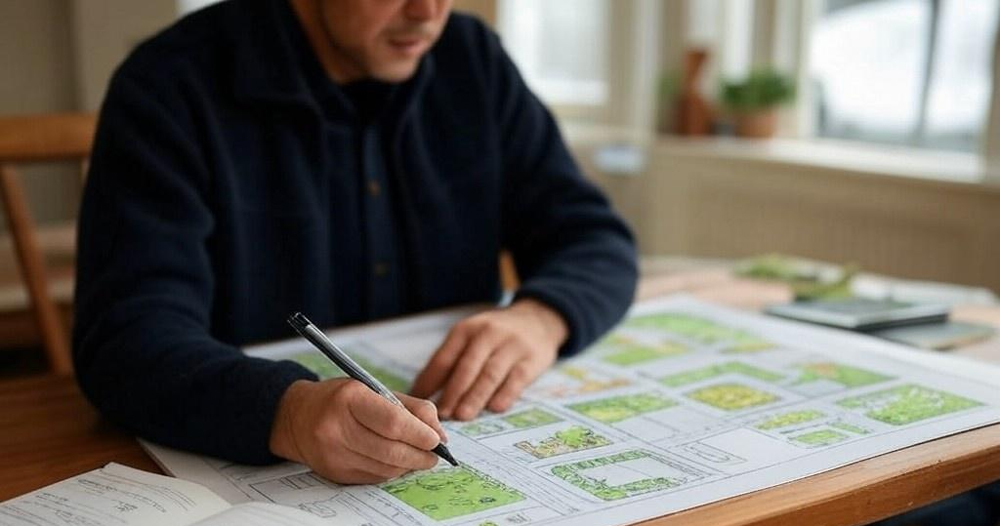
Winter is the ideal time to start planning for your spring planting, be it vegetables, perennials, annuals, or bushes and shrubs. Start with a pencil and paper—sometimes old-school methods are the most effective—and jump right in; our most successful gardeners keep an annual gardening diary or journal. This enables you to look at the previous season and see what was planted where, the fertilizer used, any issues you had that you may want to try to prevent, and how successful certain varieties were. This is especially useful when it comes to vegetable gardens and rotating crops to prevent disease and to utilize your garden soil’s nutrients to your best advantage.
We highly recommend that you start with a diagram. It doesn’t have to be fancy or to scale; just as long as you can decipher it when it is complete. The goal is to avoid over or under planting and overspending or unnecessary waste. Going into springtime with a plan will make your spring planting that much more cost-efficient and enjoyable.
VEGETABLE GARDENS
Include how many plants you will need to meet your family’s needs. On our site, each vegetable heading page will tell you how many plants are needed for each person in your household, as well as a suggestion for the number to plant for preserving if you want to enjoy the fruits of your labors year-round. If shopping someplace else and that information isn’t handy, a quick search online can give you an estimate of how many plants of a particular variety may be needed to feed your family for the season.
If this is your first vegetable garden, you do not need to worry about crop rotation. However, if you had a garden last year, you may want to plant this year’s veggies in different locations within your existing garden. This will enable you to efficiently rotate your crops to prevent nutrient depletion and minimize recurring diseases and pests that you had to contend with last planting season.
You will also want to take notice of the sun’s position throughout the day into consideration. Almost all vegetables will require at least 6 hours of sunlight daily, so be conscious of those taller plants, like tomatoes and corn or vertical climbing vegetables, to avoid planting shorter plants in their shadow.
FLOWERS or BUSHES & SHRUBS
You will want to diagram the entire yard where you will be planting, filling in the perennials and bushes and shrubs that are already there; include the name and the color if known. You may want to go so far as to take some measurements to plan most efficiently.
Remember to plan for growth to avoid overcrowding.
Take into consideration that you may want to thin or divide existing perennial plants to allow for more air circulation and to freshen the look of your flower gardens. Plot the plants you will be dividing on your diagram if you will be replanting them.
Once you have your diagram completed, make a shopping list…and stick to it! You can, of course, change your mind on the variety you will plant, but the purpose of the diagram and your research is to determine the number of vegetable plants, perennials, annuals, or bushes and shrubs that you may need. This will save you $$ by preventing ‘impulse’ buying that may overcrowd your gardens and landscape. You will also be less likely to experience buyer’s remorse. Spending wisely is a necessity.
For an even smarter approach, consider preordering your plants. Many online stores, including ours, allow you to preorder ahead of the rush, often at a discount. This ensures you’ll secure all the plants you need without worrying about stock shortages or long lines come spring. Plus, preordering gives you the freedom to plan at your own pace, adding plants to your cart as you refine your diagram and ensuring delivery at the perfect planting time for your growing zone.
Wrap It All Up with Joy
A well-planned garden is more than a project—it’s an investment in beauty, nourishment, and joy for the season ahead. By taking the time to plan thoughtfully, you’ll save money, avoid stress, and create a space that reflects your vision. Whether you’re growing vegetables for the table, flowers to brighten your yard, or shrubs to create a lush landscape, a little preparation now will lead to a thriving spring garden.
And remember, gardening isn’t just about the plants—it’s about the journey. So grab your gloves, dig in, and enjoy every moment of cultivating something beautiful.
We look forward to helping you bring your garden dreams to life. Happy gardening!
































































































































































































































































































































































































































































































































































































































































